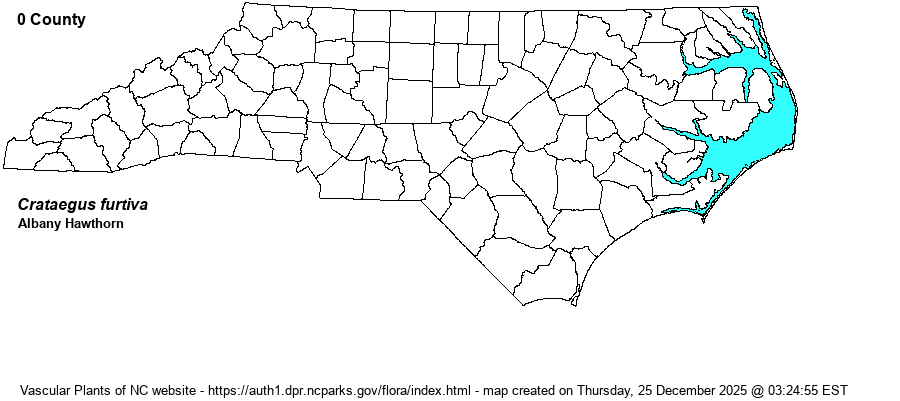| Author | Beadle | |
| Distribution | Found only in the southern third of the Coastal Plain, apparently limited mainly to the Sandhills and counties to the southeast toward the coast. This range is based on the shading on the range map in Lance (2014). However, no NC specimens of this taxon show on the SERNEC database, and the editors can find no county records to populate the map below.
A Southern Coastal Plain species that ranges only from southeastern NC to central FL and west to AL, based on the Lance (2014) map.
| |
| Abundance | Not well known, but apparently rare to uncommon in the southern Coastal Plain. Lance (2014) calls it "rare" in the state, as does Weakley's (2018) map. As with many newly named Crataegus, this is a Watch List species. | |
| Habitat | This is a species of dry and usually sandy habitats, such as pine/scrub oak sandhills, other sandy woods, and dry thickets. | |
| Phenology | Blooms from late March to April, and fruits from late August into September. | |
| Identification | This is a large shrub or small tree with a usually wide-spreading crown. It has quite wide leaves, typically widely obovate with straight and V-angled bases, and usually slightly lobed (or at least very deeply cut) outer margins. The result is a somewhat fan shape to the leaves, with a strongly serrated “fan”. It is distinctively tomentose to almost woolly in spring on the leaves and inflorescences. For other distinctions, see Weakley (2018). This taxon will likely be quite unfamiliar to most biologists, as it was not included in RAB (1968). | |
| Taxonomic Comments | Though described in 1901, it was not included in the great majority of references until very recently, such as in Lance (2014) and Weakley (2018). However, NatureServe has now given it a Global Rank of G3G5, without the Q for questionable taxonomy.
| |
| Other Common Name(s) | Apparently none | |
| State Rank | S2? | |
| Global Rank | G3G5 | |
| State Status | W7 | |
| US Status | | |
| USACE-agcp | | |
| USACE-emp | | |

